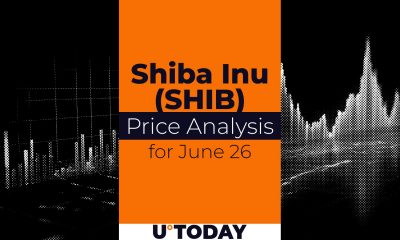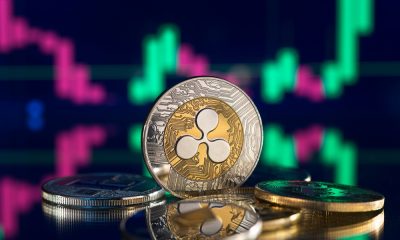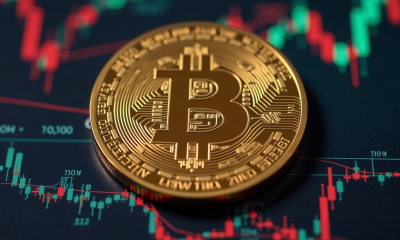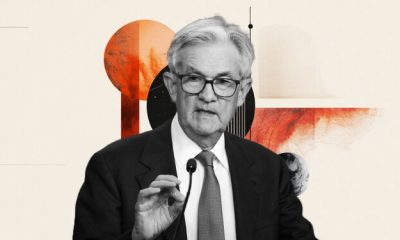

others
ISM Manufacturing PMI data likely to test US Dollar strength – Crypto News
- The US ISM Manufacturing PMI is foreseen at 47.7 in September, improving further after June’s bottom.
- ISM Prices Paid Index and Employment Index could give hints about the Federal Reserve’s next steps.
- The risk for a EUR/USD corrective advance increased as the pair has fallen for 11 weeks in a row.
The Institute for Supply Management (ISM) will publish the United States September Manufacturing Purchasing Managers’ Index (PMI) on Monday, October 2. The index is expected to have ticked modestly higher to 47.7 from its previous monthly reading of 47.6. The official Manufacturing PMI has been within contraction levels ever since falling to 49 in November 2022 and slowly moving away from the multi-year low posted last June at 46.
What to expect from the ISM manufacturing PMI report?
Beyond the modest uptick in the headline figure, market players anticipate an improvement in all sub-components. The Employment Index is foreseen at 49 from 48.5 in August, while New Orders are expected to print 47 after posting 46.8 in August. Finally, the ISM Manufacturing Prices is anticipated at 48.9 in September, up 0.5 percentage points from the former reading.
Back in August, the report indicated a ninth month of contraction after a 30-month period of expansion. More relevant, the Prices Index registered 48.4, up 5.8 percentage points compared to the July figure of 42.6. Inflation in the United States (US), as measured by the Consumer Price Index (CPI), rose by more than anticipated in August, while the core Personal Consumption Expenditures (PCE) Price Index – the Federal Reserve (Fed) favorite inflation figure –, met expectations while easing from July, up 3.9% YoY in the same month.
A higher-than-anticipated ISM Manufacturing PMI Price Index sub-component, which gauges the price change that US manufacturers pay for its inputs, would hint at persistently high inflation extending into September. That should fuel speculation about at least one more rate hike in the US and support the central banks’ idea of “higher for longer” rates. As a result, the risk of an economic setback should increase, and the US Dollar benefits from a continued run to safety.
Investors will also pay attention to the employment-related sub-component ahead of the Nonfarm Payrolls (NFP) report scheduled for Friday. The tight US labor market is a critical factor when it comes to monetary policy decisions, as it allows the central bank to maintain the restrictive policy. Policymakers see modest signs of loosening labor market conditions, not enough, however, to change the course of monetary policy.
Offering a sneak peek into the US data, analysts at BBH noted: “ISM PMIs will also be important. Manufacturing PMI will be reported Monday and the headline is expected at 47.9 vs. 47.6 in August. Keep an eye on employment and prices paid, which stood at 48.5 and 48.4 in August, respectively.”
When will the ISM Manufacturing Purchasing Managers’ Index report be released and how could it affect EUR/USD?
The ISM Manufacturing PMI report is scheduled for release at 14:00 GMT on October 2. Ahead of the data, the US Dollar trades near fresh multi-month highs against most major rivals, backed by mounting risk aversion and signs of a resilient American economy.
An upbeat headline should confirm the economy remains strong enough and that the country may dodge a recession. Such speculation should lift the mood and put pressure on the US Dollar, at least in the near term.
Strong inflation and employment sub-components, however, may spur speculation for tighter for longer Fed policy and boost USD demand amid renewed fears.
From a technical perspective, Dhwani Mehta, Asian Session Lead Analyst at FXStreet, notes that “EUR/USD is struggling below the 1.0600 threshold on its road to recovery, as 14-day Relative Strength Index (RSI) indicator continue to sit beneath the 50 level.”
“Any recovery will gather steam on a sustained move above the 1.0650 psychological level, above which the 1.0700 round figure will be on the Euro’s radar. Meanwhile, powerful support aligns near 1.0490, below which a fresh downside will open up toward the 1.0400 mark.”
Fed FAQs
Monetary policy in the US is shaped by the Federal Reserve (Fed). The Fed has two mandates: to achieve price stability and foster full employment. Its primary tool to achieve these goals is by adjusting interest rates.
When prices are rising too quickly and inflation is above the Fed’s 2% target, it raises interest rates, increasing borrowing costs throughout the economy. This results in a stronger US Dollar (USD) as it makes the US a more attractive place for international investors to park their money.
When inflation falls below 2% or the Unemployment Rate is too high, the Fed may lower interest rates to encourage borrowing, which weighs on the Greenback.
The Federal Reserve (Fed) holds eight policy meetings a year, where the Federal Open Market Committee (FOMC) assesses economic conditions and makes monetary policy decisions.
The FOMC is attended by twelve Fed officials – the seven members of the Board of Governors, the president of the Federal Reserve Bank of New York, and four of the remaining eleven regional Reserve Bank presidents, who serve one-year terms on a rotating basis.
In extreme situations, the Federal Reserve may resort to a policy named Quantitative Easing (QE). QE is the process by which the Fed substantially increases the flow of credit in a stuck financial system.
It is a non-standard policy measure used during crises or when inflation is extremely low. It was the Fed’s weapon of choice during the Great Financial Crisis in 2008. It involves the Fed printing more Dollars and using them to buy high grade bonds from financial institutions. QE usually weakens the US Dollar.
Quantitative tightening (QT) is the reverse process of QE, whereby the Federal Reserve stops buying bonds from financial institutions and does not reinvest the principal from the bonds it holds maturing, to purchase new bonds. It is usually positive for the value of the US Dollar.
-

 Blockchain1 week ago
Blockchain1 week agoCrypto Hedge Fund Veterans Seek $100M to Buy BNB, Emulating Saylor’s Bitcoin Strategy – Crypto News
-

 Blockchain1 week ago
Blockchain1 week agoChange In US Crypto Laws May Affect Charges In Do Kwon’s Criminal Case – Crypto News
-

 others7 days ago
others7 days agoGold retreats while Fed Powell and President Trump clash over interest rates – Crypto News
-

 Technology1 week ago
Technology1 week agoBranded smartwatches under ₹5000 for style and functionality: Top 10 picks for everyday wear – Crypto News
-

 Blockchain1 week ago
Blockchain1 week agoBest Crypto to Buy as Polymarket Nears $1B Valuation – Crypto News
-

 Technology1 week ago
Technology1 week agoTop 10 air coolers for monsoon: Handpicked products for effective cooling from trusted brands – Crypto News
-

 Cryptocurrency1 week ago
Cryptocurrency1 week agoSHIB Price Prediction for June 26 – Crypto News
-

 Cryptocurrency5 days ago
Cryptocurrency5 days agoFriday charts: Retail is one-upping Wall Street – Crypto News
-

 others1 week ago
others1 week agoRich Dad Poor Dad Author Says ‘Biggest Crash in History’ Approaching While Baby Boomers Lose Retirements to Inflation – Crypto News
-

 Blockchain1 week ago
Blockchain1 week agoInvestor Anthony Pompliano Launches $1B Bitcoin Treasury Firm – Crypto News
-

 Blockchain1 week ago
Blockchain1 week agoAnchorage to Integrate Uniswap to Wallet for Insitutional DeFi – Crypto News
-

 Cryptocurrency1 week ago
Cryptocurrency1 week agoWhat next for XRP after breaking above the $2.15 resistance? – Crypto News
-

 others1 week ago
others1 week agoTariffs may be adding a quarter of a percentage point to inflation right now – Crypto News
-

 Blockchain1 week ago
Blockchain1 week agoBitcoin Price Could Rally To $110,000 ATH As These Macroeconomic Factors Align – Crypto News
-

 others7 days ago
others7 days agoEUR/JPY steadies near 169.00 as traders await the next catalyst – Crypto News
-

 Blockchain1 week ago
Blockchain1 week agoBearish Breakdown Meets Bullish Flag, Which Will Prevail? – Crypto News
-

 Blockchain1 week ago
Blockchain1 week agoBearish Breakdown Meets Bullish Flag, Which Will Prevail? – Crypto News
-

 Cryptocurrency1 week ago
Cryptocurrency1 week agoBitcoin rallies to $106K on Mideast ceasefire news; Circle shares continue explosive climb – Crypto News
-

 Technology1 week ago
Technology1 week agoUS judge rules Anthropic’s use of books for AI training is fair use: All you need to know – Crypto News
-

 Technology1 week ago
Technology1 week agoOpenAI and Jony Ive’s AI hardware ambitions hit roadblock over trademark dispute: Report – Crypto News
-

 Technology1 week ago
Technology1 week agoBest laptops under ₹40,000 (June 2025) with latest processors, SSD storage, and Windows 11 features, Top 10 picks – Crypto News
-

 De-fi1 week ago
De-fi1 week agoPayments Giant Fiserv to Roll Out ‘Bank-Friendly’ Stablecoin on Solana – Crypto News
-

 others1 week ago
others1 week agoWalmart Ordered To Pay $10,000,000 After Retail Giant Allegedly ‘Turned a Blind Eye’ to Scammers Exploiting Customers – Crypto News
-

 Blockchain1 week ago
Blockchain1 week agoBitcoin Wobbles? Metaplanet Buys Big, Breaks $1 Billion Mark – Crypto News
-

 others1 week ago
others1 week agoIndian Rupee recovers as Oil falls post Iran strike, Fed dovish signals limit US Dollar strength – Crypto News
-

 Blockchain1 week ago
Blockchain1 week agoCutting Block Times To Boost Performance – Crypto News
-

 others1 week ago
others1 week agoUS stocks downplay Iran retaliation concerns as indices edge higher – Crypto News
-

 others1 week ago
others1 week agoBank of America, Netflix and Apple Customers Targeted by Widescale Google Search Scams: Report – Crypto News
-

 Blockchain1 week ago
Blockchain1 week agoTaker Buy Volume Spikes Sharply – Crypto News
-

 De-fi1 week ago
De-fi1 week agoSynaptogenix Acquires Bittensor’s TAO for AI Crypto Treasury – Crypto News
-

 Technology1 week ago
Technology1 week agoTurkey plans stricter crypto rules to fight money laundering – Crypto News
-

 others1 week ago
others1 week agoWinnebago Industries (WGO) tops Q3 earnings estimates – Crypto News
-

 Cryptocurrency1 week ago
Cryptocurrency1 week agoUS Housing Chief Orders Fannie Mae, Freddie Mac to Prepare for Crypto Assessment in Mortgages – Crypto News
-

 De-fi1 week ago
De-fi1 week agoBarclays to Ban Crypto Purchases via Credit Card – Crypto News
-

 others6 days ago
others6 days agoAI-Focused Layer-1 Blockchain Altcoin SAHARA Flames Out Following New Binance Listing – Crypto News
-

 Cryptocurrency6 days ago
Cryptocurrency6 days agoVodafone Share Price Tests 78p Ahead of July Earnings, Is a Breakout Imminent? – Crypto News
-

 Cryptocurrency6 days ago
Cryptocurrency6 days agoTRON price forecast as USDT supply surpasses $80 billion – Crypto News
-

 Technology1 week ago
Technology1 week agoTop 10 8kg washing machines in June 2025 worth checking if you want a balance of space, speed, and value – Crypto News
-

 others1 week ago
others1 week agoFactSet research (FDS) Q3 earnings lag estimates – Crypto News
-

 Technology1 week ago
Technology1 week agoGoogle introduces AI-powered Chromebook Plus 14: Features, specifications, and more – Crypto News
-

 Cryptocurrency1 week ago
Cryptocurrency1 week agoPolymarket ‘politics’ markets surge, Celestia rethinks consensus – Crypto News
-

 others1 week ago
others1 week agoBitcoin (BTC) and Ethereum (ETH) Lead $1,240,000,000 of Inflows to Crypto Products Despite Geopolitical Tensions: CoinShares – Crypto News
-

 others1 week ago
others1 week agoGerman IFO Business Climate Index rises further to 88.4 in June vs. 88.3 expected – Crypto News
-

 others1 week ago
others1 week agoJerome Powell testifies Fed is well-positioned to wait to learn more about economy – Crypto News
-

 Blockchain1 week ago
Blockchain1 week agoAptos and Jump Crypto Launch Shelby, a Web3 Cloud Storage Platform – Crypto News
-

 De-fi1 week ago
De-fi1 week agoDragonfly-Backed Codex Launches Blockchain for Stablecoins with Native USDC Support – Crypto News
-

 Technology1 week ago
Technology1 week agoUS judge rules Anthropic’s use of books for AI training is fair use: All you need to know – Crypto News
-

 Cryptocurrency1 week ago
Cryptocurrency1 week agoSolana-based StarFun lets projects raise capital with crypto – Crypto News
-

 Blockchain1 week ago
Blockchain1 week agoMany Senators Absent From ‘Bipartisan’ Crypto Market Structure Hearing – Crypto News
-

 others1 week ago
others1 week agoRight now, we’re in watch and wait mode – Crypto News







![IONQ Elliott Wave technical analysis [Video]](https://dripp.zone/news/wp-content/uploads/2025/07/IONQ-Elliott-Wave-technical-analysis-Video-Crypto-News-400x240.jpg)
![IONQ Elliott Wave technical analysis [Video]](https://dripp.zone/news/wp-content/uploads/2025/07/IONQ-Elliott-Wave-technical-analysis-Video-Crypto-News-80x80.jpg)